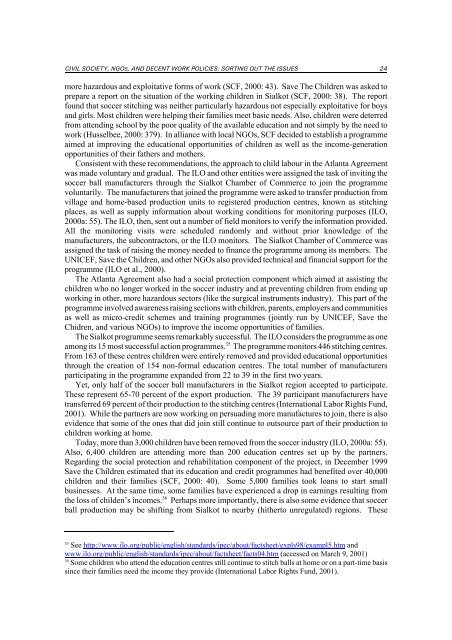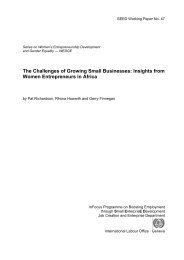Civil Society, NGOs, and Decent Work Policies: Sorting out the Issues
Civil Society, NGOs, and Decent Work Policies: Sorting out the Issues
Civil Society, NGOs, and Decent Work Policies: Sorting out the Issues
You also want an ePaper? Increase the reach of your titles
YUMPU automatically turns print PDFs into web optimized ePapers that Google loves.
CIVIL SOCIETY, NGOS, AND DECENT WORK POLICIES: SORTING OUT THE ISSUES 24<br />
more hazardous <strong>and</strong> exploitative forms of work (SCF, 2000: 43). Save The Children was asked to<br />
prepare a report on <strong>the</strong> situation of <strong>the</strong> working children in Sialkot (SCF, 2000: 38). The report<br />
found that soccer stitching was nei<strong>the</strong>r particularly hazardous not especially exploitative for boys<br />
<strong>and</strong> girls. Most children were helping <strong>the</strong>ir families meet basic needs. Also, children were deterred<br />
from attending school by <strong>the</strong> poor quality of <strong>the</strong> available education <strong>and</strong> not simply by <strong>the</strong> need to<br />
work (Husselbee, 2000: 379). In alliance with local <strong>NGOs</strong>, SCF decided to establish a programme<br />
aimed at improving <strong>the</strong> educational opportunities of children as well as <strong>the</strong> income-generation<br />
opportunities of <strong>the</strong>ir fa<strong>the</strong>rs <strong>and</strong> mo<strong>the</strong>rs.<br />
Consistent with <strong>the</strong>se recommendations, <strong>the</strong> approach to child labour in <strong>the</strong> Atlanta Agreement<br />
was made voluntary <strong>and</strong> gradual. The ILO <strong>and</strong> o<strong>the</strong>r entities were assigned <strong>the</strong> task of inviting <strong>the</strong><br />
soccer ball manufacturers through <strong>the</strong> Sialkot Chamber of Commerce to join <strong>the</strong> programme<br />
voluntarily. The manufacturers that joined <strong>the</strong> programme were asked to transfer production from<br />
village <strong>and</strong> home-based production units to registered production centres, known as stitching<br />
places, as well as supply information ab<strong>out</strong> working conditions for monitoring purposes (ILO,<br />
2000a: 55). The ILO, <strong>the</strong>n, sent <strong>out</strong> a number of field monitors to verify <strong>the</strong> information provided.<br />
All <strong>the</strong> monitoring visits were scheduled r<strong>and</strong>omly <strong>and</strong> with<strong>out</strong> prior knowledge of <strong>the</strong><br />
manufacturers, <strong>the</strong> subcontractors, or <strong>the</strong> ILO monitors. The Sialkot Chamber of Commerce was<br />
assigned <strong>the</strong> task of raising <strong>the</strong> money needed to finance <strong>the</strong> programme among its members. The<br />
UNICEF, Save <strong>the</strong> Children, <strong>and</strong> o<strong>the</strong>r <strong>NGOs</strong> also provided technical <strong>and</strong> financial support for <strong>the</strong><br />
programme (ILO et al., 2000).<br />
The Atlanta Agreement also had a social protection component which aimed at assisting <strong>the</strong><br />
children who no longer worked in <strong>the</strong> soccer industry <strong>and</strong> at preventing children from ending up<br />
working in o<strong>the</strong>r, more hazardous sectors (like <strong>the</strong> surgical instruments industry). This part of <strong>the</strong><br />
programme involved awareness raising sections with children, parents, employers <strong>and</strong> communities<br />
as well as micro-credit schemes <strong>and</strong> training programmes (jointly run by UNICEF, Save <strong>the</strong><br />
Chidren, <strong>and</strong> various <strong>NGOs</strong>) to improve <strong>the</strong> income opportunities of families.<br />
The Sialkot programme seems remarkably successful. The ILO considers <strong>the</strong> programme as one<br />
among its 15 most successful action programmes. 35 The programme monitors 446 stitching centres.<br />
From 163 of <strong>the</strong>se centres children were entirely removed <strong>and</strong> provided educational opportunities<br />
through <strong>the</strong> creation of 154 non-formal education centres. The total number of manufacturers<br />
participating in <strong>the</strong> programme exp<strong>and</strong>ed from 22 to 39 in <strong>the</strong> first two years.<br />
Yet, only half of <strong>the</strong> soccer ball manufacturers in <strong>the</strong> Sialkot region accepted to participate.<br />
These represent 65-70 percent of <strong>the</strong> export production. The 39 participant manufacturers have<br />
transferred 69 percent of <strong>the</strong>ir production to <strong>the</strong> stitching centres (International Labor Rights Fund,<br />
2001). While <strong>the</strong> partners are now working on persuading more manufactures to join, <strong>the</strong>re is also<br />
evidence that some of <strong>the</strong> ones that did join still continue to <strong>out</strong>source part of <strong>the</strong>ir production to<br />
children working at home.<br />
Today, more than 3,000 children have been removed from <strong>the</strong> soccer industry (ILO, 2000a: 55).<br />
Also, 6,400 children are attending more than 200 education centres set up by <strong>the</strong> partners.<br />
Regarding <strong>the</strong> social protection <strong>and</strong> rehabilitation component of <strong>the</strong> project, in December 1999<br />
Save <strong>the</strong> Children estimated that its education <strong>and</strong> credit programmes had benefited over 40,000<br />
children <strong>and</strong> <strong>the</strong>ir families (SCF, 2000: 40). Some 5,000 families took loans to start small<br />
businesses. At <strong>the</strong> same time, some families have experienced a drop in earnings resulting from<br />
<strong>the</strong> loss of childen’s incomes. 36 Perhaps more importantly, <strong>the</strong>re is also some evidence that soccer<br />
ball production may be shifting from Sialkot to nearby (hi<strong>the</strong>rto unregulated) regions. These<br />
35<br />
See http://www.ilo.org/public/english/st<strong>and</strong>ards/ipec/ab<strong>out</strong>/factsheet/expls98/exampl5.htm <strong>and</strong><br />
www.ilo.org/public/english/st<strong>and</strong>ards/ipec/ab<strong>out</strong>/factsheet/facts04.htm (accessed on March 9, 2001)<br />
36<br />
Some children who attend <strong>the</strong> education centres still continue to stitch balls at home or on a part-time basis<br />
since <strong>the</strong>ir families need <strong>the</strong> income <strong>the</strong>y provide (International Labor Rights Fund, 2001).
















